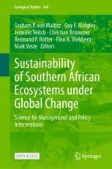Search
Search Results
-
Map** livestock grazing in semi-natural areas in the European Union and United Kingdom
ContextLivestock grazing throughout Europe has resulted in high diversity of semi-natural areas in past centuries. Currently, most low intensity...

-
Western Rangeland Livestock Production Systems and Grazing Management
Rangeland wildlife ecology and conservation is strongly influenced by domestic livestock systems. Domestic livestock production on rangelands in...
-
Strands of connection: unraveling livestock grazing effects on orb-weaver spiders
Studies on the effects of grazing disturbances in grasslands have shown mixed results for spider diversity, mainly regarding their guilds. While...

-
Space–time interactions between free-ranging red deer (Cervus elaphus) and grazing livestock on a fenced pasture
Livestock farming, which produces milk and meat, is practised by nearly all cultures. But in addition to this, grazing livestock fulfils other...

-
Giant root-rat engineering and livestock grazing activities regulate plant functional trait diversity of an Afroalpine vegetation community in the Bale Mountains, Ethiopia
Disturbances from rodent engineering and human activities profoundly impact ecosystem structure and functioning. Whilst we know that disturbances...

-
Comparison of the bird community in livestock farms with continuous and rotational grazing in eastern Uruguay
Grassland birds are the most endangered bird group in Uruguay, mainly due to habitat loss. Livestock farming is the most widespread agricultural...

-
Assessment of livestock grazing pressure in key tiger habitat in a semi-arid landscape in Western India
Loss of pasture lands and increased livestock population has resulted in higher livestock dependency on the forest lands. Kailadevi Wildlife...

-
Grazing distribution of wild guanacos and livestock in Patagonian rangelands: an ecological approach to assess mixed carrying capacity and overgrazing risk in extensive pastoral systems
ContextAlong with forage availability, rangeland’s carrying capacity (CC) is determined by other landscape features limiting the spatial distribution...

-
The landscapes of livestock diversity: grazing local breeds as a proxy for domesticated species adaptation to the environment
ContextDomesticated animals play a central role in agricultural landscapes. However, livestock has been scarcely studied from a spatial perspective....

-
Livestock Sector
Livestock is an integral part of the socio-economic fabric of rural India since ancient times, being a source of livelihood and a provider of draft...
-
Strategies for Sustainable Climate Smart Livestock Farming
Climate Smart Farming (CSF) emphasize on sustaining the farming by creating resilience in the practices through reorientation or transformation in...
-
Management of Grazing Lands
A grazing land is defined as a land unit consisting mostly of herbaceous and shrub vegetation where animals graze (Fig. 18.1). While it primarily...
-
Silvopastoral systems in local livestock landscapes in Hopelchén, Southern Mexico
Deforestation for livestock remains one of Mexico’s key socio-environmental problems. The municipality of Hopelchén is a deforestation hotspot...

-
Exploring grazing intensity effects: nitrogen uptake in grassland species and soil carbon allocation
Background and aimsGrazing drives carbon (C) and nitrogen (N) dynamics of grasslands through livestock trampling, defoliation, and excretion. Still,...

-
The effect of shrub community on understory soil seed bank with and without livestock grazing
Shrub communities often modify understory soil and vegetation characteristics. However, the effect of individual shrubs on the soil seed bank (y6SSB)...

-
Influence of grazing intensity on richness, phylogenetic and functional dimensions of highly diverse mountainous grasslands from Mazandaran, Iran
Recently, more studies have focused on predicting plant response to livestock grazing by using plant functional traits as indicators to study species...

-
A Fine Line Between Carbon Source and Sink: Potential CO2 Sequestration through Sustainable Grazing Management in the Nama-Karoo
Semiarid South African ecosystems are managed for livestock production with different practices and intensities. Many studies have found grazing to...
-
Spatio-temporal epidemiology of livestock diseases in the variable semi-arid rangelands of northern Kenya
Diseases affecting livestock can have significant impacts on the animal, humans and the economy. Participatory epidemiology and spatial analysis were...

-
Short-term grazing diminished ecosystem multifunctionality of grassland in northern China
Background and AimsGrasslands play important roles in production as well as having ecological functions. Grazing affects grassland ecosystem...

-
Effect of burn season and grazing deferment on mountain big sagebrush plant communities
Fire and grazing play an important role in managed rangeland ecosystems. These disturbances interact to shape plant communities and outcomes for...

